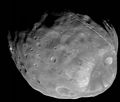Fichier:Phobos colour 2008.jpg

Gréisst vun dëser Duerstellung: 636 × 600 Pixel. Aner Opléisungen: 255 × 240 Pixel | 509 × 480 Pixel | 815 × 768 Pixel | 1.086 × 1.024 Pixel | 2.172 × 2.048 Pixel | 3.500 × 3.300 Pixel.
Original Fichier (3.500 × 3.300 Pixel, Fichiersgréisst: 2,72 MB, MIME-Typ: image/jpeg)
Versiounen
Klickt op e bestëmmten Zäitpunkt fir déi respektiv Versioun vum Fichier ze kucken.
| Versioun vum | Miniaturbild | Dimensiounen | Benotzer | Bemierkung | |
|---|---|---|---|---|---|
| aktuell | 03:10, 2. Abr. 2018 |  | 3.500 × 3.300 (2,72 MB) | Kaldari | more margin on right side |
| 04:47, 13. Nov. 2008 |  | 3.374 × 3.300 (2,7 MB) | Fir0002 | == Summary == {{Information |Description=Colour image of Phobos, imaged by the Mars Reconnaisance Orbiter in 2008 |Source=NASA |Date=9 April 2008 |Location=http://www.nasa.gov/mission_pages/MRO/multimedia/pia10368.html |Author=NASA/J |
Benotze vu Fichieren
Dës Säit benotzt dëse Fichier:
Globaalt Benotze vum Fichier
Dës aner Wikie benotzen dëse Fichier:
- Benotzt op af.wikipedia.org
- Benotzt op an.wikipedia.org
- Benotzt op ar.wikipedia.org
- المريخ
- فوبوس
- قمرا المريخ
- ويكيبيديا:صور مختارة/الفضاء والكون/نظرة إلى الأعلى
- قائمة أجرام المجموعة الشمسية مرتبة حسب الحجم
- بوابة:علم الفلك/صورة مختارة
- بوابة:المريخ
- بوابة:المريخ/مقالة مختارة/أرشيف
- بوابة:المريخ/مقالة مختارة/2
- قائمة الأقمار الطبيعية
- خط زمني لاكتشاف كواكب المجموعة الشمسية وأقمارها
- ويكيبيديا:ترشيحات الصور المختارة/القمر فوبوس
- ويكيبيديا:صورة اليوم المختارة/أغسطس 2019
- قالب:صورة اليوم المختارة/2019-08-03
- بوابة:علم الفلك/صورة مختارة/73
- معسكر قاعدة المريخ
- ويكيبيديا:صورة اليوم المختارة/يناير 2022
- قالب:صورة اليوم المختارة/2022-01-04
- Benotzt op ary.wikipedia.org
- Benotzt op arz.wikipedia.org
- Benotzt op as.wikipedia.org
- Benotzt op azb.wikipedia.org
- Benotzt op az.wikipedia.org
- Benotzt op be-tarask.wikipedia.org
- Benotzt op be.wikipedia.org
- Benotzt op bg.wikipedia.org
- Benotzt op bh.wikipedia.org
- Benotzt op bn.wikipedia.org
- Benotzt op bn.wikibooks.org
- Benotzt op bs.wikipedia.org
Kuckt globale Gebrauch vun dësem Fichier.




